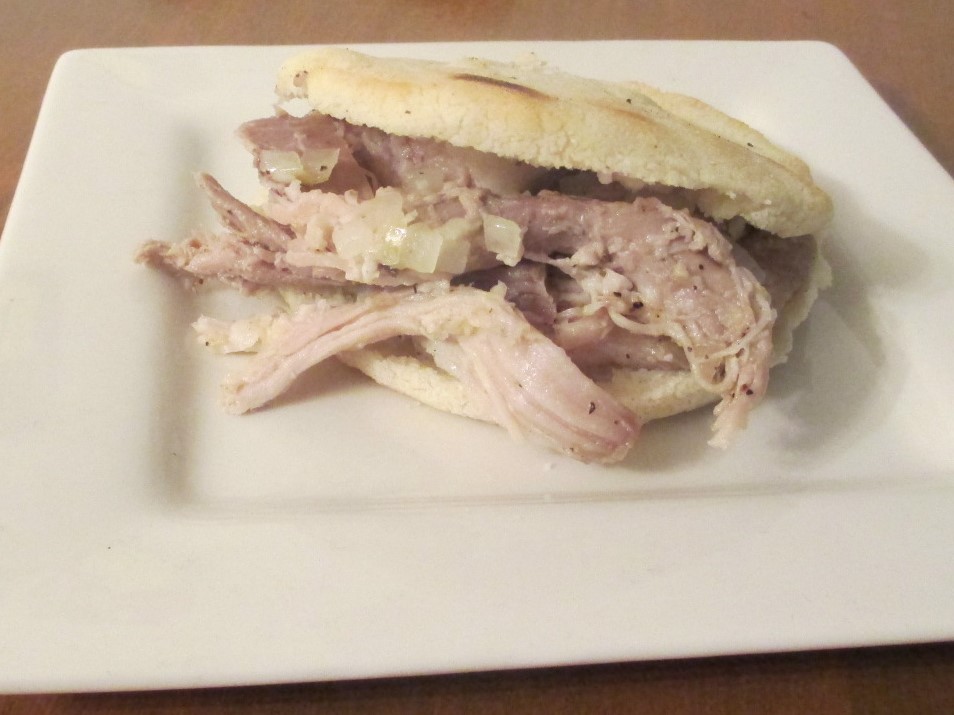Skip to Recipe
Arepas are savory flatbreads made of corn flour and griddled, fried, or baked. They are are widely consumed in Colombian and Venezuelan cuisine, so it’s only natural that I have eaten my fair share of arepas in my lifetime. Colombians generally serve them as a side to go with a protein (steak, chicharrones, sausage). My mother and aunt usually served them spread with melted butter or a slice of queso blanco melted on top. Simple, but delicious. I was able to coax the recipe out of my aunt several years ago, and have been sitting on it ever since. They just seemed like a lot of work, or I just never got around to it.
Then, I started dating a Venezuelan guy. We had a few debates on which of our home countries was better at arepas. Venezuelans, he argued, stuffed their arepas with meats and other sorts of fillings that made them far better than the plain cheese ones found in Colombia. Cheese, I would say, is all you really need. That is, until he took me to a little Venezuelan spot in Doral and introduced me to the classic Venezuelan “arepa sandwich.” I had to concede that the Venezuelans were doing it right, and finally decided to give arepa-making a shot – with a Venezuelan twist. And, while the Venezuelan gentleman is no longer in the picture, he at least left behind the knowledge that such deliciousness exists out there. On that merit alone, I have no regrets. Now, I get to spend more time with my one, TRUE love: food.
This recipe is essentially a combination of the instructions on the corn flour package, my aunt’s recipe, and this recipe.
First, gather your ingredients.
A standard arepa doesn’t take much, as you can see. My mother and aunt sometimes grind their own corn. If you know how to do that, and feel inclined to do so, have at it. For the rest of us, there is precooked corn flour. I usually am able to find it in the “Baking Needs” aisle of my local grocery store. Otherwise, try looking in a Latin grocery store.
Measure out your corn flour and salt in a mixing bowl, and pour in the water. Make sure your water is hot. Then, melt your butter and pour it in. The butter is optional, but it does enhance the flavor and texture of the arepa.
Using your hands or a very sturdy spoon, start mixing your flour and water mixture up.
In the end, you should be able to ball your dough up. Once it’s at this stage, you can start forming your arepas. Some recipes indicate that you should let the dough rest for 5 minutes or more. I never do that, and have not had any issues. This is probably also a good time to start pre-heating whatever you will be cooking your arepas in, too.
Start by rolling a piece of the dough into a ball, then start flattening it out by lightly pinching it with your thumb and forefinger. Start from the middle and work your way towards the edges until you have a disc of dough. You can smooth out the edges with your fingers. If the dough starts to crack, wet your hands with a little bit of warm water and work it into the dough.
I set my “arepa patties” aside on a cookie sheet until I am ready to start cooking them.
There are several different ways you can cook an arepa. They can be griddled, baked, fried, or even grilled. My family would always place a rack above the stovetop burners and cook them that way. So, that is the way I am doing it here.
After a few minutes (6 minutes on my stove top, to be exact), flip them over and cook the other side until lightly browned. If you like yours a little bit darker, feel free to cook them longer.
Once they are done, let them cool on a wire rack. You don’t want to put them on a plate if you are not going to eat them right away, because the bottom might get soggy. At this point, your arepa is ready for consumption. However, since we’re rolling “Venezuelan style” today, we’re going to stuff our arepa.
I can neither confirm nor deny the relative safety of the method that I am using to split my arepas. I will say that I have yet to cut myself. You want to cut it almost all the way through, but leave a small part still attached so that it opens like a hinge. Think laptop or Pac Man (weird analogies, I know). Arepas are typically a bit mushy and sticky on the inside, so don’t be alarmed if some of the arepa starts sticking to your knife. However, if you are losing large portions of your arepa to the knife, then you might not have cooked it long enough.
Stuff your split arepa with the filling of your choice. I’m using a Cuban-style pulled pork as my filling.
Then, dig in!
There you have it. Easy, right? It might take a little bit of practice to get your arepas formed and shaped, but they’re not terribly difficult to whip up in a pinch. Just be sure you have enough stove top space to cook more than one at a time. They also freeze really well, so you can make a large batch and freeze the leftovers.
My recipe will only cover the stove top grill method, but you can find detailed information on the other methods of arepa-making at Venezuelan Cooking. She really breaks it down and makes it easy to follow.
Arepas
Ingredients
- 2 cups white corn flour (Harina PAN)
- 2 ½ cups hot (not boiling) water
- 1 tsp salt
- 2 tbsp unsalted butter, melted (optional)
Directions
Combine all of your ingredients in a large bowl using your hand or a sturdy spoon until you have a slightly firm dough. Make sure to break up all the little clumps that may have formed in the dough.
Place a metal baking rack above one of your small stove top burners. Pre-heat on medium to medium-high.
Take a small handful of the dough and roll into a ball about 2″ in diameter. Flatten the ball using your fingers into a disc about ½” thick. Repeat until no dough remains.
Place on top of the baking rack and cook for 6-7 minutes on each side, or until lightly browned. Serve immediately.













